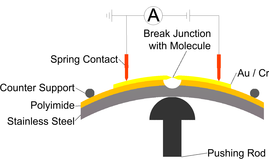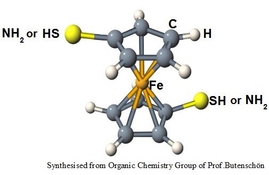Molecular electronics
The ultimate goal of molecular electronics is to use single molecules as a building blocks for future device structures. In order to follow this modular concept where the device functionality is defined by the electronic properties of the molecules detailed knowledge about the electronic interaction with their environment, e.g. metallic nano-contacts, is essential. Therefore, several experimental techniques like mechanically and electrically controlled break junctions (MCBJ, electromigration induced openings), atomic force microscopy as well as spectroscopy are employed to comprehensively characterize the embedded molecules with respect to their structure, adsorption sites, electronic properties and transport behavior.
Our research group is focusing among others on the electronic properties of ferrocene based organic molecules. Their rotational flexibility of the Cp-rings against each other ensures per se a relaxed adsorption within truly nm-sized gap structures. By transport experiments the influence of different end groups (-SH-NH2), conformation of the molecules with respect to electrodes, controlled stretching of the molecules and activation of vibrational modes is systematically investigated.






